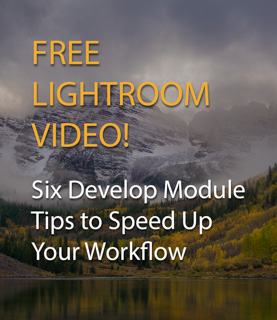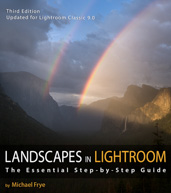In the Moment:
Michael Frye's Landscape Photography Blog
by Michael Frye | Jun 28, 2015 | Light and Weather, Yosemite Photo Conditions
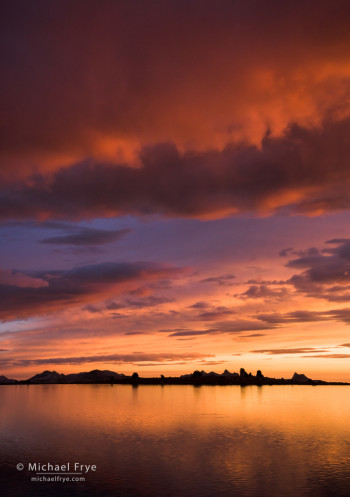
Sunset over an alpine lake, Yosemite
After a long stretch of blue skies, subtropical moisture is moving into the Sierra Nevada this week. That means clouds, thunderstorms, maybe a rainbow or two, and possibly even a chance to photograph lightning – in other words, photography weather! Here are the forecasts for Yosemite Valley and Tuolumne Meadows.
This is a typical weather pattern for the Sierra in summer. We’ll get stretches of clear blue skies, then subtropical moisture will move in for a few days, a week, or sometimes even longer, triggering afternoon showers and thunderstorms. Although some clouds and showers are likely this week, it’s hard to predict exactly what will happen on any given day, as the individual storm cells are usually small and localized, and can form and dissipate quickly. It helps to watch which direction the clouds are moving, and, if you can get an internet connection, keep an eye on weather radar. Of course you need to stay away from lightning, and avoid high, exposed ridges when thunderstorms are around.
(more…)
by Michael Frye | Jun 21, 2015 | Travels and Stories
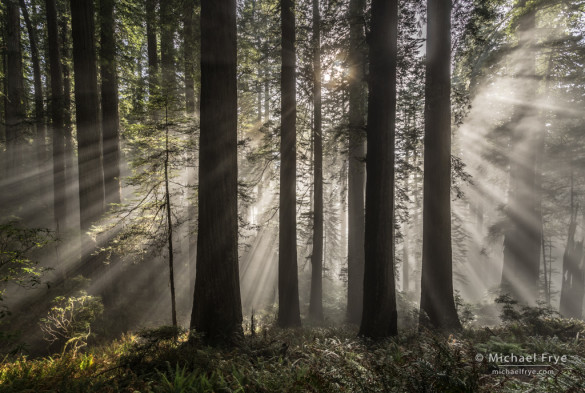
Sunbeams in a redwood forest, northern California coast
Today is the solstice, the official start of summer. It’s felt like summer for weeks here in the Sierra foothills. It’s been hot, and dry. Four (!) fires broke out near Mariposa and Oakhurst Thursday; fortunately they were all subdued quickly.
(more…)
by Michael Frye | May 14, 2015 | Composition
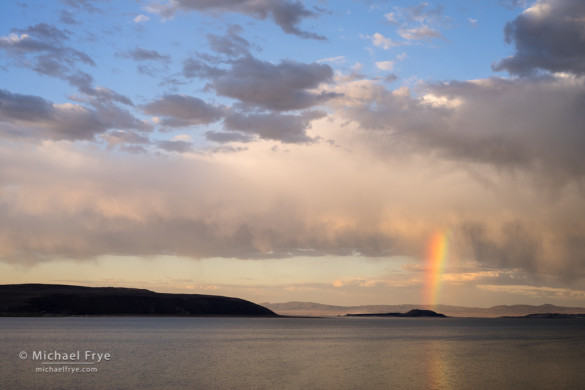
Rainbow over Negit Island, Mono Lake, California. Although I made other compositions of this scene with longer lenses, I liked the slightly wider perspective created by a normal 50mm lens, because it allowed me to include some of the blue sky.
The “normal” lens doesn’t get much love. Longer and shorter focal lengths seem more attractive, because they create unusual perspectives. As I wrote in this recent post, wide-angle lenses stretch space and make things look farther apart, sometimes creating a sense of depth, while telephoto lenses compress space and makes objects look closer together, helping to emphasize patterns and juxtapositions.
I, too, was guilty of disdain for the normal lens for many years. Although I used normal lenses (around 50mm for full-frame cameras, or about 35mm for APS-size sensors) for two decades with my film cameras, for a ten-year stretch the only lenses I used with my Canon DSLRs were 17-40mm and 70-200mm zooms. I never felt the need to fill the gap between 40mm and 70mm because I usually wanted to go either wide or long. On the rare occasions when I needed a focal length between 40mm and 70mm, I used 40mm and cropped.
(more…)
by Michael Frye | Apr 16, 2015 | Composition
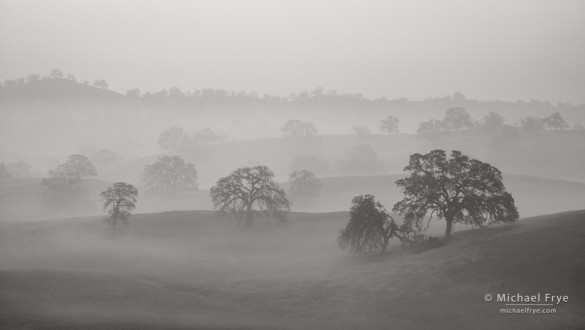
Blue oaks in fog 2, Sierra Nevada foothills
Ansel Adams was quoted as saying, “A good photograph is knowing where to stand.” I’m sure he said this with tongue slightly in cheek – he knew full well that the art of photography was more complex than that. But he was trying to emphasize the importance of putting the camera in the right spot. Not just in the general vicinity, like “F/8 and be there,” but in exactly the right spot, and not an inch to the left, right, forward, back, up, or down.
Compare the two photographs shown here. In the photograph below, I moved left and right to place the three most prominent oaks between the trees behind them. But try as I might, I couldn’t completely separate the foreground and background trees, so I climbed further up the hillside behind me and made the image above. This higher camera position created better spacing and separation between the foreground and background oaks, and a composition I’m much happier with.
(more…)
by Michael Frye | Mar 31, 2015 | Night Photography
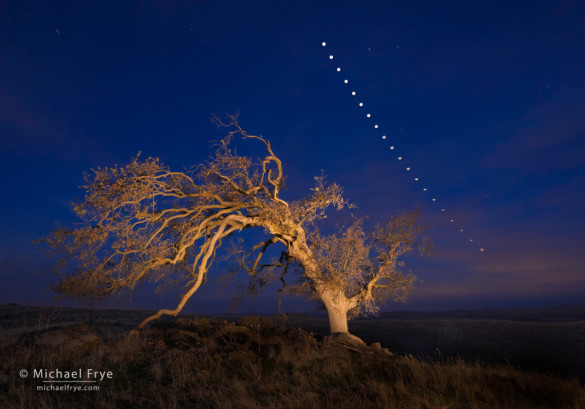
Oak tree and lunar eclipse sequence, Mariposa County, Sierra foothills, December 2011
Another total lunar eclipse will be visible in western North America this Saturday morning, April 4th. This is the third lunar eclipse in a sequence of four: we had two last year, and there will be another one on September 27th this year. But after that you won’t be able to see another total lunar eclipse in North America until 2018.
This upcoming eclipse will be brief; the total eclipse will last only five minutes! But for photography that’s enough. Here in California the eclipse will be visible in the west-southwest, about 18 degrees above the horizon, just before dawn. Since the moon will be low in the sky, you might be able to photograph it next to an interesting foreground object. You can find more details about this eclipse here.
For precise guidance about the moon’s position in relation to the landscape, I recommend consulting PhotoPills or The Photographer’s Ephemeris. Here’s the timing for the eclipse:
(more…)






